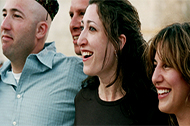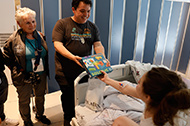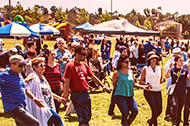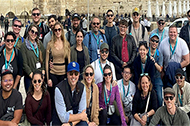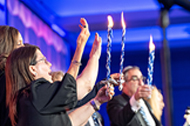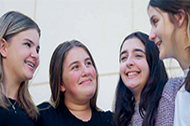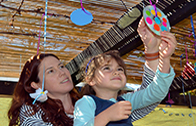Reflections from Day 1- Alan Viterbi
11/28/2023
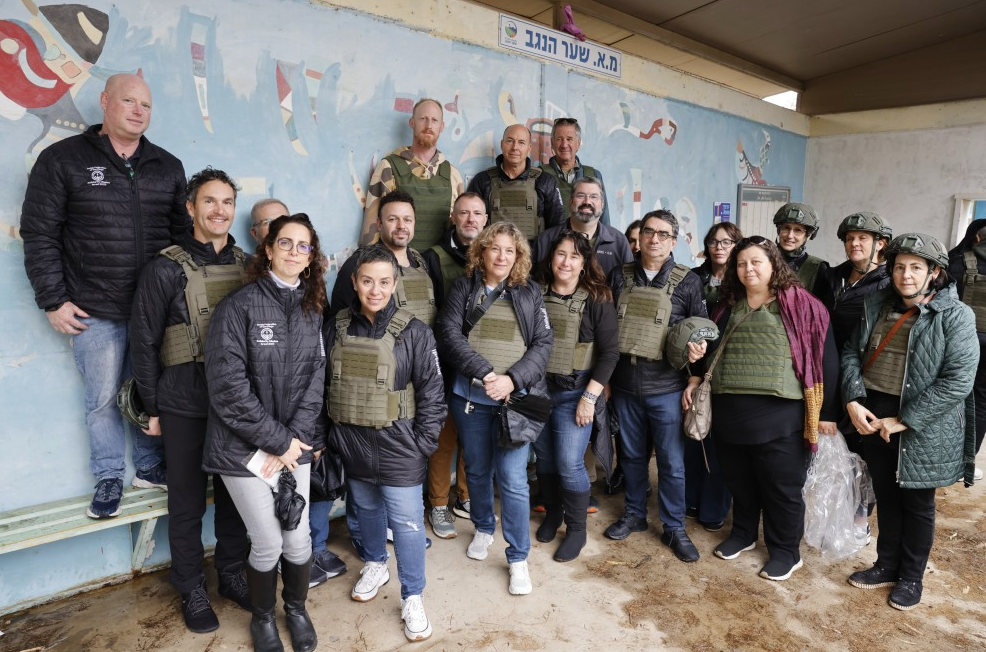
Written by Alan Viterbi on November 27, 2023
Hard to know where to begin. Today, we covered much of the south of Israel and traveled a wide range of emotions.
We boarded the bus in Jerusalem to head down to our sister city, Sha’ar HaNegev. Our guide, Itzik, who many of us knew from last May’s trip, reintroduced himself to the group. To understand the framework of how most Israelis define themselves today, he began explaining who he was by saying where he was on October 7th, and how his life has changed. Itzik is a major in the paratrooper reserves. He woke up to the red alert for incoming missiles. Although religiously observant, that sabbath and holiday morning, he immediately turned on his phone, learned of the atrocities underway, and woke his two daughters of military age, both in the reserves, and each left home to join their units. His unit served in the Gaza theater, seeing the devastation in the Israeli communities along the border, before being assigned to the northern border, which remains a zone of active hostile activity from Hezbollah, including daily rocket and missile attacks. His unit has been assigned the task of retaking Israel’s northernmost city (already evacuated for weeks) in the case of a Hamas-style cross-border invasion by Hezbollah, which the IDF clearly believes is a real-world risk. As we drove south, passed by motorcades (which we later understood included visits to where we were headed Elon Musk accompanied by Netanyahu, as well as the President of the German parliament along with the Speaker of the Israeli Knesset), Itzik highlighted one of the small but meaningful ways in which everyday Israeli life is impacted. Waze no longer provides anticipated drive time to your destination, as this would allow Hamas, which has equal access to the web, to identify traffic jams, which present opportunities for mass casualties for a missile attack.
As we approached Sha’ar HaNegev, we passed a chilling sight. An improvised parking lot of hundreds of cars. Some burned to a crisp, although most appeared in good condition. This is where all the cars of those who attended the Nova music festival but were unable to retrieve their cars were taken. The magnitude of the murders and hostage-taking of young people celebrating music and peace, the themes of the festival, were evident in looking at these abandoned cars.
 After undertaking security precautions, we entered Kfar Aza, one of the most devastated of the kibbutzim on October 7th. This was a beautiful agricultural community that many of us knew well and which a good number of us had visited just this past May. Bullet holes, gaping holes caused by rocket-propelled grenades, and massive destruction was evident throughout the kibbutz. We saw where the paragliders flew into the kibbutz that morning, dropping grenades and firing machine guns at anyone they saw. As we set out on foot to visit the young adult apartments on the western side, a mere mile from the Gaza barrier and close to where the Hamas terrorists in pickup trucks breached the western gate of the kibbutz, the scenes of destruction became near total. The small homes where 20 and 30-year-olds, mostly unmarried, lived looked like a gruesome crime scene. 10’ by 20’ homes, literally pocked with hundreds of bullet holes, doors blown off, and, in most cases, everything charred by fire. Because of the more famous visitors this morning, we encountered and received a chance briefing from the head of the IDF’s search and rescue team, who has traveled the world to assist in disasters (e.g. at the collapse of the Surfside condominiums in Florida). He described to us what it was like to locate and recover the bodies at the Nova Festival and Kfar Aza. He showed us where the children of friends of ours were murdered but said he could not describe the mutilated state in which he found them for our sakes, as he could not erase these images from his own mind. He also shared that his unit operated in Gaza in the last couple weeks. The most disturbing thing he came away with was that in every house he entered in Gaza, he found children’s school notebooks. On the cover of every notebook he found, there was a picture of a Hamas martyr, celebrated for having murdered Israeli civilians. He said that seeing this cemented for him the challenge Israel faces in successive generations in Gaza being educated to aspire to martyr status when taking the lives of his country’s innocents.
After undertaking security precautions, we entered Kfar Aza, one of the most devastated of the kibbutzim on October 7th. This was a beautiful agricultural community that many of us knew well and which a good number of us had visited just this past May. Bullet holes, gaping holes caused by rocket-propelled grenades, and massive destruction was evident throughout the kibbutz. We saw where the paragliders flew into the kibbutz that morning, dropping grenades and firing machine guns at anyone they saw. As we set out on foot to visit the young adult apartments on the western side, a mere mile from the Gaza barrier and close to where the Hamas terrorists in pickup trucks breached the western gate of the kibbutz, the scenes of destruction became near total. The small homes where 20 and 30-year-olds, mostly unmarried, lived looked like a gruesome crime scene. 10’ by 20’ homes, literally pocked with hundreds of bullet holes, doors blown off, and, in most cases, everything charred by fire. Because of the more famous visitors this morning, we encountered and received a chance briefing from the head of the IDF’s search and rescue team, who has traveled the world to assist in disasters (e.g. at the collapse of the Surfside condominiums in Florida). He described to us what it was like to locate and recover the bodies at the Nova Festival and Kfar Aza. He showed us where the children of friends of ours were murdered but said he could not describe the mutilated state in which he found them for our sakes, as he could not erase these images from his own mind. He also shared that his unit operated in Gaza in the last couple weeks. The most disturbing thing he came away with was that in every house he entered in Gaza, he found children’s school notebooks. On the cover of every notebook he found, there was a picture of a Hamas martyr, celebrated for having murdered Israeli civilians. He said that seeing this cemented for him the challenge Israel faces in successive generations in Gaza being educated to aspire to martyr status when taking the lives of his country’s innocents.
Walking around the kibbutz was eerie. There were all the signs of life from October 6th, frozen in that moment, other than the destruction all around. The sukkahs, temporary festival booths, from the holiday, were still there, as were the election posters for Ofir Libstein’s reelection, which was to have taken place in early November. But most of the homes showed signs of the attack, and many were destroyed. On many doors were the spray-painted indications that booby traps left by Hamas had been identified and then removed by the IDF bomb squad, and the all too frequent notice on the house which signified that a dead body had been removed from it. Today, no civilians are living in Kfar Aza as it is considered dangerous and under IDF control. However, as we crossed the kibbutz, we met one woman who, upon seeing us, asked to speak to our group. She introduced herself as the mother of Doron Steinbrecher, a 30-year-old woman taken as a hostage in Gaza. Her daughter lived in the young adults quarter, while she and her husband lived in the family section of the kibbutz. She said that she had come to gather a few objects from her daughter’s home to have for her if she gets released to make her feel more at home. She began to cry and said her daughter was not a child, but she was her child, like so many of the hostages. She beseeched us to tell the world that she too deserved to come home.
 We left Kfar Aza in silence. The next stop was the Sha’ar HaNegev sports center, built in part with funds raised by the San Diego Jewish community in the wake of the 2014 Hamas missile barrages against Israel. The sports center is missile-resistant and was designed to create a safe space for the community to gather. The sports center has become a rest and recovery site for troops taking brief breaks from Gaza, where they can get a warm meal and take showers before returning to Gaza. We joined a logistics and medical evacuation unit for lunch, with the meal prepared for and donated by volunteers who traveled there to serve the troops. The unit consisted of reservists. Some had been called up; others simply showed up because they wanted to serve regardless of not having been called up. The medical evacuation team was made up of physicians, normally in private practice, who met IDF ambulances at the border, stabilize patients, and get them to the nearest hospital. The logistics unit included software engineers, El Al employees, and every walk of life. They were tired but deeply committed to what needed to be done. The commander, a Lt. Col., shared with us the unity he saw in the country, having put aside the deep political, religious, and other divides that existed before October 7th. His comment was evident in the troops surrounding him. The message he wanted to convey to us was that Israel would prevail in this war and that Hamas would be destroyed. He explained it wasn’t an option. Israel would not allow the perpetrators of mass murder and mutilation from October 7th to ever threaten Israelis again.
We left Kfar Aza in silence. The next stop was the Sha’ar HaNegev sports center, built in part with funds raised by the San Diego Jewish community in the wake of the 2014 Hamas missile barrages against Israel. The sports center is missile-resistant and was designed to create a safe space for the community to gather. The sports center has become a rest and recovery site for troops taking brief breaks from Gaza, where they can get a warm meal and take showers before returning to Gaza. We joined a logistics and medical evacuation unit for lunch, with the meal prepared for and donated by volunteers who traveled there to serve the troops. The unit consisted of reservists. Some had been called up; others simply showed up because they wanted to serve regardless of not having been called up. The medical evacuation team was made up of physicians, normally in private practice, who met IDF ambulances at the border, stabilize patients, and get them to the nearest hospital. The logistics unit included software engineers, El Al employees, and every walk of life. They were tired but deeply committed to what needed to be done. The commander, a Lt. Col., shared with us the unity he saw in the country, having put aside the deep political, religious, and other divides that existed before October 7th. His comment was evident in the troops surrounding him. The message he wanted to convey to us was that Israel would prevail in this war and that Hamas would be destroyed. He explained it wasn’t an option. Israel would not allow the perpetrators of mass murder and mutilation from October 7th to ever threaten Israelis again.
Before leaving lunch, we had a special treat; we had a brief meet-up with Josh, the brother of Sara Brown (and brother-in-law of Elliott Nahmias) for those who know them, who is a reservist and tank commander currently operating in the area. He swapped shifts with someone else to swing by and see his sister’s friends. He brought a soldier in his unit, who was living in Barcelona on October 7th, dropped everything, and came home to serve. He reinforced the commitment and the unity evident in Israeli society. He had seen the things we had seen earlier that morning, and he said Israel could not live with a threat like this anymore.
From there, we headed southeast for two hours to reach Mitzpe Ramon. On the drive, Yahel, the special projects manager for Sha’ar HaNegev, shared with us the experience of each kibbutz within Sha’ar HaNegev on October 7th. Most were lucky, but several were not. He said the biggest question is whether people will return this time. He said the dividing line was not across each kibbutz; it was most frequently within each household. The question of security was paramount, followed by the community’s ability to serve the psychological needs of the residents of every age. In Mitzpe Ramon, we visited the cramped temporary living quarters for Kibbutz Erez in youth hostels and modest hotels, with families of 5 or 6 sharing a single room with bunk beds. Many of the kibbutz members work in agriculture or kibbutz factories and are unable to return to work, so they sit and wait in this small town in the desert. The 52 days since they arrived is clearly wearing on people.
 They did take pride in their ability to service the needs of their children. Even before the government organized and provided funding, each kibbutz had established its own educational programs, from daycare for 6-month-olds through high school. Volunteers stepped into the breach, setting up programs using donations from the host community. Within days, they realized they needed to bring in professional educators and have the proper educational supplies. The funding from the Jewish Federation of San Diego’s emergency campaign provided the vital funding to get these programs launched in the weeks before government resources flowed. In the first two weeks after the attack, San Diego wired $2.6 million to the regional council to strengthen these educational programs in 12 different refugee locations across the country.
They did take pride in their ability to service the needs of their children. Even before the government organized and provided funding, each kibbutz had established its own educational programs, from daycare for 6-month-olds through high school. Volunteers stepped into the breach, setting up programs using donations from the host community. Within days, they realized they needed to bring in professional educators and have the proper educational supplies. The funding from the Jewish Federation of San Diego’s emergency campaign provided the vital funding to get these programs launched in the weeks before government resources flowed. In the first two weeks after the attack, San Diego wired $2.6 million to the regional council to strengthen these educational programs in 12 different refugee locations across the country.
We ended the evening in a pub having beers with the Kibbutz Erez Emergency Rescue Team, which had drilled for terrorist events for twenty years. That morning, this training and a little luck, plus hours of pitched battle, ensured the dozens of terrorists seeking to breach the kibbutz security fence did not enter. We had seen what happened in Kfar Aza when they succeeded in entering the kibbutz. That morning, Erez learned what was happening in nearby kibbutzim, opened their emergency center, alerted their emergency response team of volunteers, and assigned them to key locations across the kibbutz. Nine fighters held off the terrorists for seven hours until the army finally arrived. They had one kibbutz security volunteer killed and two badly injured, but the rapid actions of the team saved the kibbutz. Their closing observation to us was that they were committed to returning to Kibbutz Erez when the war with Hamas was won, but that the challenges would be immense. The children and parents of October 6th were no longer the same people, and the care and nurturing of both generations would be long and require much attention.
A closing thought: Throughout our first evening and today, we have heard and seen horrors that none of us will ever forget. We witnessed the worst barbarities that man can perpetrate. But we also saw incredible resilience. People volunteering to serve in combat, people preparing meals at their own expense to feed those serving, and people rushing to take care of the children displaced from their homes. We saw a people united in purpose, with a sense of being one people with a shared destiny. And we experienced gratitude. Every day Israelis thanked us for being here, in the middle of a war, to make sure they knew people thousands of miles away care for them and couldn’t sleep at night knowing they couldn’t sleep at night. And they thanked us for President Biden and America standing beside them, understanding Israel’s need to destroy the evil that threatens the safety of their children. They have many long weeks or months ahead of them. Over 200,000 of them are displaced from their homes, and over 350,000 of them are serving in the military instead of working at their civilian jobs. The economy is suffering, and tomorrow, we will visit some of the thousands who have been injured by Hamas. And even when this is over, and Hamas is no longer a threat, they will still need to rebuild their homes, their lives, and nurture themselves back to a healthy state of mind. But each of us left today certain that they will do all this, and that we must continue to stand by their side.

